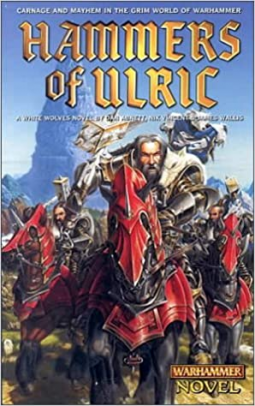
Hammers of Ulric
by Dan Abnett, Nik Vincent, James Wallis
This title was previously available on NetGalley and is now archived.
Send NetGalley books directly to your Kindle or Kindle app
1
To read on a Kindle or Kindle app, please add kindle@netgalley.com as an approved email address to receive files in your Amazon account. Click here for step-by-step instructions.
2
Also find your Kindle email address within your Amazon account, and enter it here.
Pub Date 4 Feb 2011 | Archive Date 3 Sep 2020
Talking about this book? Use #HammersofUlric #NetGalley. More hashtag tips!
Description
As the forces of evil gather around the ancient mountain fortress of Middenheim, City of the White Wolf, only the Templar Knights of Ulric, led by Wolf Company Commander Ganz, stand between the city and ultimate annihilation.
Available Editions
| EDITION | Ebook |
| ISBN | 9780857871312 |
| PRICE | £6.99 (GBP) |
Featured Reviews
 Stefan F, Reviewer
Stefan F, Reviewer
A classic Warhammer novel. Comprised of short stories featuring characters in the City of the White Wolf, Middenheim, there is a cohesive overall narrative. There's action, intrigue, and more. I re-read this when it popped up on NetGalley because I have fond memories of this era of Black Library fiction. I remember enjoying this, and my memory was not wrong. It's not the best book BL has published, but it was nice to revisit the Old World. (If you're looking for more Oldhammer fiction, then I'd recommend Will King et al's Gotrek & Felix novels, which are superb.)
 Michael B, Reviewer
Michael B, Reviewer
While this is an older book in regards to the timeline for the Warhammer books, this was quite enjoyable. The book is divided in sections and made up of novellas and short stories, they are combined seamlessly to tell a larger story about the Wolf Templars and their adventures in and around city and its danger. There were three distinct stories being told but they combined into a consistent voice showing different perspectives. Building to the climax tale, each story gave just enough insight into what was coming next and built on the tension throughout the narrative. The action was grim and exciting with scenes of emotional connection and character interaction.
While being part of the genre of game-related fiction, this didn't fall into the trap of writing about the game but stayed true to telling a great story that just happened to be set in Warhammer.
 Reviewer 556997
Reviewer 556997
A curate’s egg reissue of classic Warhammer fantasy.
Falling somewhere between a traditional short story collection and a novel, this book follows various events and adventures in the lives of different individuals over the course of a year in Middenheim. We have a group of White Wolf knights (templars of the war god Ulric in the Warhammer World), a priest of Morr (the god of death) with a sideline in investigation and a mysterious past, a thief, connected to the shady underworld of the city and a young servant. Whilst they, largely, start off separate, the threads of the individual characters’ stories are slowly woven together until eventually they collide.
If it had been executed better, this could be brilliant. Some of it is very good: some of the short stories are not simply good tie-in game fiction, but good fantasy stories. The stories told by the priest are excellent, with an unexpected depth. The first story featuring the thief Kruza and a boy known as Wheezer has touches that might remind the reader of Clark Ashton Smith’s amoral adventurers tangling with the weird and unknown. Unfortunately, these tend to be at the start of the collection, meaning the overall impression at the end is less impressive than it would otherwise be.
Part of the problem is that with three different authors attempts to provide a consistent tone to the final couple of stories is a hard act. Part of the problem is that there are contradictions between different stories (we never learn the name the priest now calls himself, only the name he left behind on becoming a priest but this is the name he is referred to as when used in a later story by a different writer). Part of the problem is that it is hard and less satisfying to force an overall structure to bring together all the disparate strands. Much of the problem is that the concluding stories simply aren’t that good. Which is a pity because overall this still a collection well worth a look..



